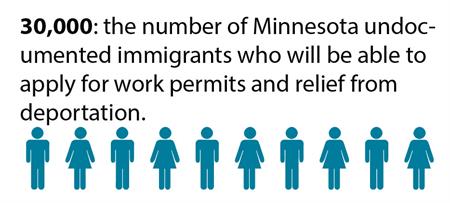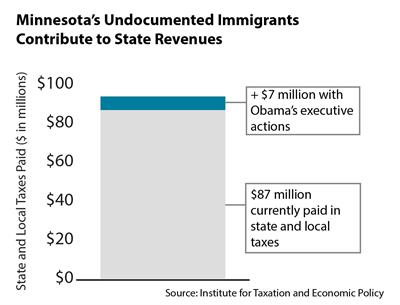Throughout our nation’s history, immigrants have come to the United States in search of opportunities to build a better life for themselves and their families. Immigrants put their skills to work, and build our workforce and revitalize communities. But federal immigration policy has not kept up with the nation’s economic needs. As a result, there are many immigrants who have strong ties in their communities, but who do not have a legal status. Many have been in the country for a long time and have children who are American citizens. Others came to the U.S. as small children and don’t recognize any other home.
In November 2014, President Barack Obama issued an executive action that would provide a temporary legal status for millions of immigrants in the United States, including thousands of Minnesotans. This action would recognize the contributions these residents make to their local communities and economies, and keep families together who already call the United States their home. It also would provide an economic boost, as young people who grew up here can further their educations and careers, and workers can build their skills and earnings.
Obama’s executive action would create a temporary, yet more stable legal status for some undocumented immigrants with significant roots in the United States. The executive action has two primary components:
- Expanded eligibility for Deferred Action for Childhood Arrivals (DACA). DACA, created in 2012, allows undocumented immigrants who entered the country as young children to request “deferred action,” or relief from deportation, and work authorization. The President’s executive action would expand DACA to cover people who entered the United States before they turned 16 and have lived in the country continuously since 2010.[1]
- Creation of Deferred Action for Parents of Americans and Lawful Permanent Residents (DAPA). Similar to DACA, DAPA would allow undocumented parents whose children are U.S. citizens or lawful permanent residents to apply for work authorization and deferred action. These parents are also required to have resided continuously in the United States since 2010.

Applicants for both DACA and DAPA would need to pass a background check and cannot be found to have been convicted of any serious crimes or have gang or terrorism involvement. Those accepted into DACA or DAPA would receive deferred action and work permits that would last for three years.
Undocumented immigrants would have access to better jobs and greater opportunity through this executive action, but it would not make them eligible for federal assistance such as Supplemental Nutrition Assistance Program (SNAP), Temporary Assistance for Needy Families (TANF) or subsidies under the Affordable Care Act.
It’s estimated that 3.9 million immigrants, including approximately 30,000 Minnesotans, would be eligible to apply for deferred action and work permits under the President’s executive order.[2] However, implementation of the executive order is on hold. Originally, applications for the expanded DACA were expected to be available in February, with the roll-out for the new DAPA program expected in May. A federal judge in Texas halted Obama’s executive action, and the executive action cannot be implemented until a lawsuit involving 26 states is resolved.
Proposed Executive Action Would Provide an Economic Boost
Obama’s executive action is a common-sense way to recognize the contributions of immigrants already working in our communities, and to realize the investment we have made in young people who have grown up here.
With legal work status, immigrants are expected to invest more in their job skills and education, further increasing their value in the economy and boosting their future earnings. Implementing Obama’s executive action would be expected to bring a 5 to 10 percent wage increase for these immigrants.[3] As immigrants earn higher wages, they have more to spend in their communities, with a resulting boost to local businesses.
Implementing DACA and DAPA would bring some undocumented immigrants out of the economic shadows. With legal work status, those working in the cash economy could be paid in the same manner as their co-workers, and would be less susceptible to being taken advantage of by their employers.
The proposed executive action also means building a stronger future workforce by giving young people who have grown up here the opportunity to further their education and skills.
Building the skills of our workforce could especially pay off for Minnesota. With increased access to higher education and training, undocumented immigrants would become better prepared to meet the state’s expected labor shortage as a significant share of Minnesota’s skilled workers begin to retire from the workforce. Additionally, the executive action would allow more of the state’s undocumented immigrants to apply for driver’s licenses, which gives them access to more job options.

The anticipated economic boost from Obama’s executive action would also bring increased tax revenues to Minnesota. Minnesota’s undocumented immigrants already pay an estimated $87 million in state and local taxes.[4] As immigrants are able to work in jobs more in line with their skills, get to their jobs more reliably, and earn more, they will also contribute more in taxes. Implementation of Obama’s executive action would generate an estimated $7 million more in state and local taxes in Minnesota.[5]
But the positive benefits for the state of implementing Obama’s executive action are dependent on those eligible being able to navigate the process of applying for DAPA and DACA. The state can do its part to make sure eligible Minnesota residents are able to apply for DAPA and DACA, should the order be implemented. For example, bills introduced in the Minnesota Legislature in 2015 would fund competitive grants to nonprofits to assist those potentially eligible for DAPA and DACA to complete the complex paperwork needed to enroll.[6]
While the timeline for implementation of Obama’s executive action is uncertain, if implemented it would build a stronger workforce and keep families with strong ties to the community together. Millions of immigrants in the United States, including 30,000 in Minnesota, would have a more stable status that would enable them to work in jobs that align with their abilities, build their skills and earn higher wages. Young people who have grown up here would be able to build the bright future that is available to their classmates and neighbors. Both the state and national economy would benefit.
By Clark Biegler
[1] Immigration Policy Center, A Guide to the Immigration Accountability Executive Action, March 2015.
[2] Pew Research Center, Immigrants in Western States Most Likely to Benefit from Obama’s Executive Action, November 2014.
[3] Fiscal Policy Institute, President’s Immigration Action Expected to Benefit Economy, November 2014.
[4] Institute on Taxation and Economic Policy, Undocumented Immigrants’ State and Local Tax Contributions, April 2015.
[5] This estimate includes the effect of Obama’s 2012 and 2014 executive actions. The 2012 executive action established the DACA program.
[6] These bills are House File 178, lead author Representative Karen Clark, and Senate File 140, lead author Senator Sandra Pappas.